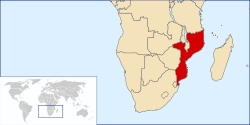This article needs additional citations for verification. (June 2011) |
Province of Mozambique | |||||||||||||||
|---|---|---|---|---|---|---|---|---|---|---|---|---|---|---|---|
| 1505–1975 | |||||||||||||||
| Anthem: "Hymno Patriótico" (1808–34) Patriotic Anthem "Hino da Carta" (1834–1910) Hymn of the Charter "A Portuguesa" (1910–75) The Portuguese | |||||||||||||||
 Location of Mozambique in Africa | |||||||||||||||
| Status | Territory of the Portuguese Empire (1505–1951) Overseas province of Portugal (1951–1972) State of the Portuguese Empire (1972–1975) | ||||||||||||||
| Capital | Cidade de Pedra (1507–1898) Lourenço Marques (1898–1975) | ||||||||||||||
| Common languages | Portuguese | ||||||||||||||
| Religion | Roman Catholicism | ||||||||||||||
| Head of state | |||||||||||||||
• 1505–1521 | King Manuel I of Portugal and the Algarves | ||||||||||||||
• 1974–75 | President Francisco da Costa Gomes | ||||||||||||||
| Governor-General | |||||||||||||||
• 1505–1506 | Pêro de Anaia (first) | ||||||||||||||
• 1974–75 | Vítor Manuel Trigueiros Crespo (last) | ||||||||||||||
| Historical era | Imperialism | ||||||||||||||
• Established | 1505 | ||||||||||||||
• Independence of Mozambique | 25 June 1975 | ||||||||||||||
| Currency | Mozambican real (1852–1914) Mozambican escudo (1914–75) | ||||||||||||||
| ISO 3166 code | MZ | ||||||||||||||
| |||||||||||||||
| Today part of | Mozambique | ||||||||||||||
Portuguese Mozambique (Portuguese: Moçambique Portuguesa) or Portuguese East Africa (África Oriental Portuguesa) were the common terms by which Mozambique was designated during the period in which it was a Portuguese overseas province. Portuguese Mozambique originally constituted a string of Portuguese possessions along the south-east African coast, and later became a unified province, which now forms the Republic of Mozambique.
Portuguese trading settlements—and later, territories—were formed along the coast and into the Zambezi basin from 1498 when Vasco da Gama first reached the Mozambican coast. Lourenço Marques explored the area that is now Maputo Bay in 1544. The Portuguese increased efforts for occupying the interior of the colony after the Scramble for Africa, and secured political control over most of its territory in 1918, facing the resistance of some Africans during the process.
Some territories in Mozambique were handed over in the late 19th century for rule by chartered companies like the Mozambique Company (Companhia de Moçambique), which had the concession of the lands corresponding to the present-day provinces of Manica and Sofala, and the Niassa Company (Companhia do Niassa), which had controlled the lands of the modern provinces of Cabo Delgado and Niassa. The Mozambique Company relinquished its territories back to Portuguese control in 1942, unifying Mozambique under control of the Portuguese government.
The region as a whole was long officially termed Portuguese East Africa, and was subdivided into a series of colonies extending from Lourenço Marques in the south to Niassa in the north. Cabo Delgado was initially merely a strip of territory along the Rovuma River, including Cape Delgado itself, which Portugal acquired out of German East Africa in 1919, but it was enlarged southward to the Lurio River to form what is now Cabo Delgado Province. In the Zambezi basin were the colonies of Quelimane (now Zambezia Province) and Tete (in the panhandle between Northern Rhodesia, now Zambia, and Southern Rhodesia, now Zimbabwe), which were for a time merged as Zambezia. The colony of Moçambique (now Nampula Province) had the Island of Mozambique as its capital. The island was also the seat of the Governor-General of Portuguese East Africa until the late 1890s, when that official was officially moved to the city of Lourenço Marques. Also in the south was the colony of Inhambane, which lay north-east of Lourenço Marques. Once these colonies were merged, the region as a whole became known as Moçambique.
According to the official policy of the Salazar regime, inspired on the concept of Lusotropicalismo, Mozambique was claimed as an integral part of the "pluricontinental and multiracial nation" of Portugal, as was done in all of its colonies to Europeanise the local population and assimilate them into Portuguese culture. This policy was largely unsuccessful, however, and African opposition to colonisation led to a ten-year independence war that culminated in the Carnation Revolution at Lisbon in April 1974 and the independence from Portugal in June 1975.

